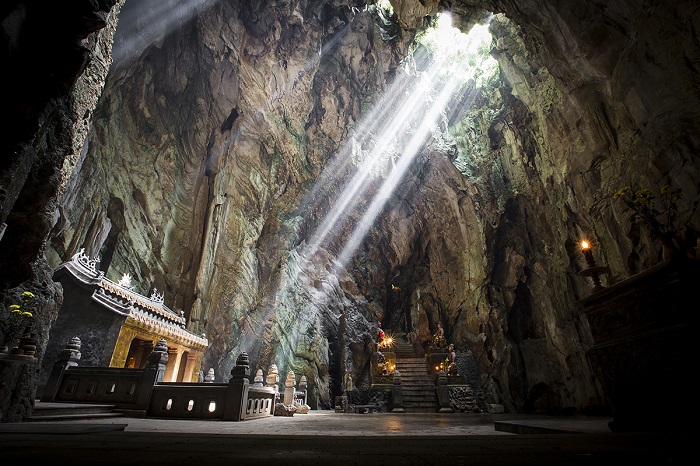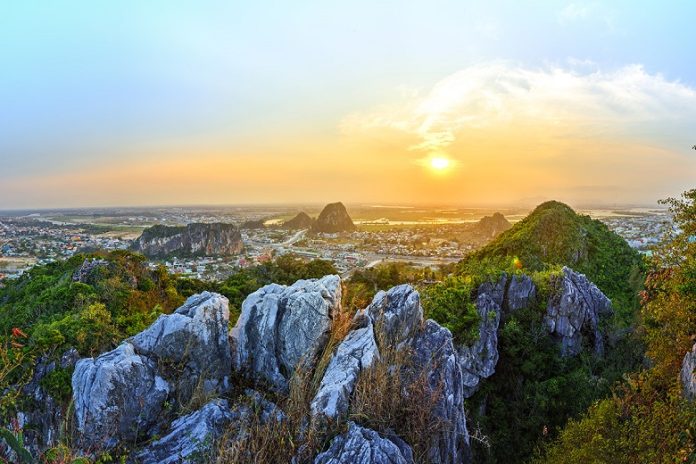Vietnam is rich in beautiful places, protagonists of multiple legends, and featuring inimitable characteristics that no other place in the world has. One of these is undoubtedly the Marble Mountains, (in Vietnamese: Ngũ Hành Sơn, lit. “five-elements mountains”).
Located just outside the city of Da-Nang, these mountains are a cluster of five marble and limestone hills, which used to be islands and now emerge from the surrounding rice fields. In January 2019, these natural formations received the National Special Relic certificate from the Ministry of Culture, Sports and Tourism of Vietnam.
History of da-nang
Da-Nang is a continuously developing city, rich in modern facilities, nightlife, and sparkling hotels, protected and embraced by the Marble Mountains and their sanctuaries and pagodas. Located right in the middle of Vietnam territory, its history is sadly marked by wars and airstrikes; however, after more than 40 years since the end of the Vietnam war, the city has returned to being a very peaceful place, in an enchanting natural landscape, where big buildings and beaches are the sings of a rapidly growing tourism and economy. As of today, in fact, the city is classified as an industrial area thanks to its harbor, which is capable of handling the traffic of containers.
Da-Nang counts almost 5000 industries, the most important of which are:
- The export industry of fishery products;
- The production of furniture, home accessories, and textiles;
- The manufacturing industry.
Right at the feet of the Marble Mountains, in fact, there are marble factories and laboratories dealing with the realization of sculptures: this has been one of the most profitable traditional jobs in Da-Nang for about 400 years. Here, some time ago, artisans would create religious, artistic sculptures and also small souvenirs, tools for domestic use, and pieces of jewelry, using the marble extracted from the mountains (which is also where the gems decorating Ho Chi Minh’s mausoleum come from); today, instead, the extraction of marble from the famous peaks is prohibited by law, and marble is imported from the surrounding areas.

Between temples, pagodas, and natural caves
The Marble Mountains can be found about 25 km away from Hoi An, on the road to Da-Nang. Located in a sacred and mystic place, these mountains are five promontories that took shape in a naturally marble-rich area: each mountain is the symbol of one of the five natural elements – earth, water, fire, metal, and wood – after which it takes its name: Thuy Son (water), Moc Son (fire), Hoa Son (wood), Kim Son (metal) e Tho Son (earth). Along the path that leads uphill, towards the peak of each mountain, it is possible to admire and explore natural caves, gorges, small valleys, and religious sanctuaries where to meditate and practice yoga, often crossing paths with monks kneeled in the pavilions, praying, and huge marble statues representing Buddha, hidden in little ravines in the rocks.
Expositions of marble sculptures
Surrounding the five mountains, what stands out is the perfectly organized and picturesque exposition of marble sculptures, which inevitably attract visitors by showing them artifacts of different shapes and dimensions: Buddha, Bodhisattva, and Madonnas of all kinds which, when exploring the various regions of Vietnam and looking up towards the roofs of the houses, will not be hard to find on the terraces, as well. As of today, the intense manufacturing of items and statues that characterizes the area, as mentioned above, differently from a few years ago, doesn’t depend on the marble extracted from the five mountains anymore, which would otherwise be irreversibly spoiled and would have lost the aura of magic and mystery they are famous for: now, marble for the construction of souvenirs and sculptures is imported more and more significantly from China.
Source: www.marmomac.com








































